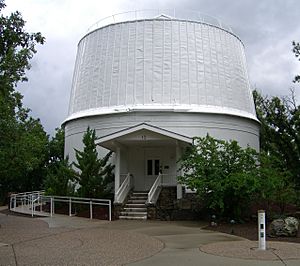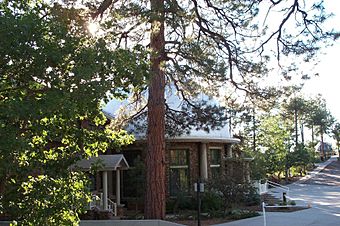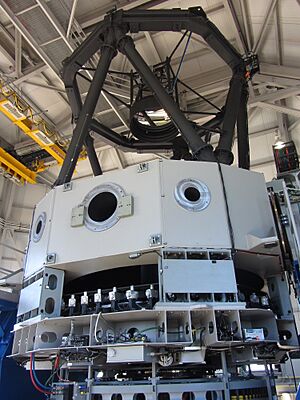Lowell Observatory facts for kids
Quick facts for kids Lowell Observatory |
|||||||||||||||||||||||||||||||||||||||||||||||||||
|---|---|---|---|---|---|---|---|---|---|---|---|---|---|---|---|---|---|---|---|---|---|---|---|---|---|---|---|---|---|---|---|---|---|---|---|---|---|---|---|---|---|---|---|---|---|---|---|---|---|---|---|

The Clark Telescope Dome on Mars Hill
|
|||||||||||||||||||||||||||||||||||||||||||||||||||
| Organization | Private institution | ||||||||||||||||||||||||||||||||||||||||||||||||||
| Location | Flagstaff, Arizona | ||||||||||||||||||||||||||||||||||||||||||||||||||
|
Coordinates
|
35°12′10″N 111°39′52″W / 35.20278°N 111.66444°W
|
||||||||||||||||||||||||||||||||||||||||||||||||||
| Altitude | 2,210 m (7,250 ft) | ||||||||||||||||||||||||||||||||||||||||||||||||||
| Established | 1894 | ||||||||||||||||||||||||||||||||||||||||||||||||||
|
|||||||||||||||||||||||||||||||||||||||||||||||||||
Lowell Observatory is a famous place in Flagstaff, Arizona, United States, where people study space. It was started way back in 1894, making it one of the oldest observatories in the country. Because of its important history, it was named a National Historic Landmark in 1965. In 2011, Time Magazine even called it one of "The World's 100 Most Important Places"! A huge discovery happened here in 1930: the dwarf planet Pluto was found by an astronomer named Clyde Tombaugh.
The observatory was founded by Percival Lowell, who came from a well-known family in Boston. Today, a single trustee oversees the observatory, a role that has traditionally stayed within the Lowell family.
In 1963, several astronauts visited Lowell Observatory. They were helping to map the Moon for the Apollo Program, which was a big step towards sending humans to the Moon.
Lowell Observatory uses many different telescopes in the Flagstaff area. The main site on Mars Hill is home to the original 24-inch Clark Refracting Telescope. This telescope, built in 1896, is now used for public education. Over 85,000 people visit it each year! Also on Mars Hill is the 13-inch Pluto Discovery Telescope. This is the very telescope Clyde Tombaugh used in 1930 to find Pluto.
In 2014, the Putnam Center opened. This building has a library for research and rooms for old tools and artifacts used by astronomers. While some areas are just for scientists, many parts of the observatory are open for visitors to explore.
Lowell Observatory also has four research telescopes at its Anderson Mesa Station, a dark-sky site about 20 kilometers (12 miles) southeast of Flagstaff. These include the 72-inch Perkins Telescope and the 42-inch John S. Hall Telescope. Lowell also works with the U.S. Naval Observatory on the Navy Precision Optical Interferometer (NPOI) at this site.
Even further out, on the peak of Happy Jack, Arizona, Lowell Observatory built the 4.28-meter Lowell Discovery Telescope. This powerful telescope was built in partnership with Discovery Communications, Inc.
Contents
History of Lowell Observatory
In 1877, an Italian astronomer named Giovanni Schiaparelli thought he saw "canals" on Mars. Percival Lowell was very interested in this idea of artificial canals. In 1893, he decided to use his money to build an observatory in the United States. He hired astronomer Andrew E. Douglas to find the best spot. In 1894, they chose Flagstaff, Arizona. It was perfect because of its high elevation, dark night skies, and easy access by train. The building materials were local, but the famous Clark Refracting Telescope was put together in Boston.
The observatory has done many kinds of research over the years. One early project was measuring how much sunlight changes. Later, scientists focused on studying light from planets like Uranus and Neptune. In 1953, a 21-inch telescope was set up to monitor the brightness of these planets.
A self-taught astronomer named Robert Burnham Jr. worked at Lowell Observatory from 1958 to 1979. He is famous for his book, Celestial Handbook.
Camps for Kids
Starting in 2012, Lowell Observatory began offering special camps for children called LOCKs (Lowell Observatory Camps for Kids). The first camp was for elementary students. In 2013, they added a program for preschool children. The next year, they created a camp for middle school students. Kids at these camps get to learn about science, technology, engineering, and math (STEM) in fun, hands-on ways. They do experiments, play games, listen to stories, create art, and more!
In 2016, Kevin Schindler wrote a book called Lowell Observatory. This book has over 200 pictures and captions. It was part of Arcadia Publishing's Images of America series. The book helped more people learn about Lowell Observatory's history and the amazing discoveries made by its scientists.
Explore the Exhibits
Lowell Observatory has several exciting exhibits for visitors:
- The Rotunda Museum: Built in 1916, this building was once a library. Now, it displays artifacts and tells the story of the Lowell family. You can also learn about the discoveries made at the observatory. It even has old measuring tools like Thatcher's Calculating Instrument.
- Putnam Collection Center/ Lowell's Lunar Legacy: When the Rotunda Museum is closed, these areas are open to the public. The Center shows off the observatory's history. It features artifacts from Lowell's past and other scientific breakthroughs.
- The Giovale Open Deck Observatory: This is the newest part of Lowell Observatory. Guests can learn about astronomy both day and night. It has six telescopes and a special display showing the spectrum of light. The telescopes include a 5.5-inch TEC wide-field refractor and a large 32-inch Starstructure Dobsonian reflector.
Lowell Discovery Telescope
The Lowell Discovery Telescope (LDT) is owned and operated by Lowell Observatory. It is located near Happy Jack, Arizona. This 4.3-meter (169-inch) reflecting telescope is the fifth-largest telescope in the United States. It's one of the most powerful in the world! It has a special design that lets it use up to five different instruments. This means it can switch between tools in about a minute. This makes it great for studying things that change quickly, like gamma ray bursts and supernovae.
The main mirror of the LDT weighs 6,700 pounds (about 3,000 kg). It is 4.3 meters (169 inches) across but only about 10 centimeters (4 inches) thick. This thin mirror is kept in perfect shape by a system of 156 active parts. The mirror was shaped at the University of Arizona in Tucson.
The LDT is inside a metal dome that is 73 feet (22 meters) tall and 62 feet (19 meters) wide. It sits at an elevation of 7,800 feet (2,377 meters). Building the facility started on July 11, 2005. Six years later, the first image from the telescope was taken. The secondary mirror was put in place in January 2012. To celebrate, Lowell Observatory held a big event on July 21, 2012. Neil Armstrong, the first person on the Moon, gave a speech. This was his last public appearance before he passed away a few weeks later.
The telescope is named after the Discovery Channel television network. The founder of Discovery, John Hendricks, has been a member of Lowell Observatory's board for a long time. Discovery and John and Maureen Hendricks gave $16 million towards the $53 million cost of the project. These were gifts, not purchases. Discovery does not own the telescope or tell scientists what research to do. In return for their help, they received naming rights and the first chance to use images for educational TV shows. Scientists use the telescope for research just like any other professional telescope.
Several universities also partner with Lowell Observatory to use the LDT. These include Boston University, the University of Maryland, the University of Toledo, Northern Arizona University, and Yale University.
Current Research at Lowell Observatory
Astronomers at Lowell Observatory study many things in space. They use telescopes on the ground, in the air, and in space. Some of their current projects include:
- Searching for near-Earth asteroids that could come close to our planet.
- Surveying the Kuiper Belt, a region of icy objects beyond Neptune.
- Looking for extrasolar planets, which are planets outside our solar system.
- A long-term study of how much the Sun's brightness changes.
- Investigating how stars form and other processes in distant galaxies.
The staff at Lowell also designs and builds special instruments for telescopes. For example, they built a fast camera for SOFIA. SOFIA is a joint project with NASA and the German space agency. It uses a 2.5-meter (8.2-foot) telescope inside a Boeing 747 SP airplane.
Lowell astronomers also helped with NASA's Double Asteroid Redirection Test (DART). This experiment was the world's first full-scale test to see if we could protect Earth from an asteroid.
Amazing Discoveries
Lowell Observatory has been part of many important discoveries:
- The dwarf planet Pluto was discovered by Clyde Tombaugh in 1930.
- Vesto Melvin Slipher found that galaxies are moving away from us very quickly between 1912 and 1914. This helped scientists realize our universe is expanding!
- The co-discovery of the rings of Uranus in 1977.
- The changing activity of Comet Halley during its visit in 1985/1986.
- Finding the three largest known stars.
- Discovering the atmosphere of Pluto.
- Figuring out the exact paths of Pluto's moons: Nix and Hydra.
- Finding oxygen on Jupiter's moon Ganymede.
- Discovering Carbon dioxide ice on three of Uranus's moons.
- Finding the first Trojan of Neptune (an asteroid sharing Neptune's orbit).
- Evidence that the atmosphere of a planet called HD 209458 b contains water vapor.
Images for kids
See also
 In Spanish: Observatorio Lowell para niños
In Spanish: Observatorio Lowell para niños
- List of astronomical observatories
- List of largest optical telescopes in the continental United States






